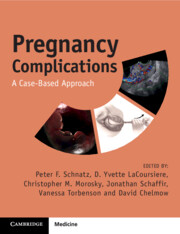Book contents
- Pregnancy Complications
- Pregnancy Complications
- Copyright page
- Contents
- Contributors
- Preface
- Note from the Editor-in-Chief
- Normal Laboratory Values (Conventional Units) []
- Section 1 Antepartum (Early Pregnancy)
- Section 2 Antepartum (Mid-trimester)
- Case 12 A 25-Year-Old with Cervical Insufficiency at 18 Weeks
- Case 13 A 25-Year-Old with an Echogenic Cardiac Focus at 19 Weeks’ Gestation
- Case 14 A 20-Year-Old with Right Lower Quadrant Pain at 15 Weeks’ Gestation
- Case 15 A 40-Year-Old with Decreased Libido at 29 Weeks
- Case 16 A 35-Year-Old with a Left Breast Mass at 35 Weeks
- Case 17 A 25-Year-Old at 14 Weeks’ Gestation with Pelvic Pain and Inability to Void
- Case 18 A 35-Year-Old with Abdominal Cramping and Pelvic Pain at 24 Weeks’ Gestation
- Case 19 Appendicitis Presenting as Nausea, Vomiting, and Abdominal Pain at 16 Weeks
- Section 3 Antepartum (Late Pregnancy)
- Section 4 Antepartum (Medical Complications)
- Section 5 Antepartum (Infectious Complications)
- Section 6 Intrapartum/Delivery
- Section 7 Postpartum
- Section 8 Fetal Complications
- Section 9 Placental Complications
- Section 10 Complications of the Cord, Amnion, and Gravid Uterus
- Section 11 Psychosocial Considerations
- Index
- References
Case 18 - A 35-Year-Old with Abdominal Cramping and Pelvic Pain at 24 Weeks’ Gestation
from Section 2 - Antepartum (Mid-trimester)
Published online by Cambridge University Press: 08 April 2025
- Pregnancy Complications
- Pregnancy Complications
- Copyright page
- Contents
- Contributors
- Preface
- Note from the Editor-in-Chief
- Normal Laboratory Values (Conventional Units) []
- Section 1 Antepartum (Early Pregnancy)
- Section 2 Antepartum (Mid-trimester)
- Case 12 A 25-Year-Old with Cervical Insufficiency at 18 Weeks
- Case 13 A 25-Year-Old with an Echogenic Cardiac Focus at 19 Weeks’ Gestation
- Case 14 A 20-Year-Old with Right Lower Quadrant Pain at 15 Weeks’ Gestation
- Case 15 A 40-Year-Old with Decreased Libido at 29 Weeks
- Case 16 A 35-Year-Old with a Left Breast Mass at 35 Weeks
- Case 17 A 25-Year-Old at 14 Weeks’ Gestation with Pelvic Pain and Inability to Void
- Case 18 A 35-Year-Old with Abdominal Cramping and Pelvic Pain at 24 Weeks’ Gestation
- Case 19 Appendicitis Presenting as Nausea, Vomiting, and Abdominal Pain at 16 Weeks
- Section 3 Antepartum (Late Pregnancy)
- Section 4 Antepartum (Medical Complications)
- Section 5 Antepartum (Infectious Complications)
- Section 6 Intrapartum/Delivery
- Section 7 Postpartum
- Section 8 Fetal Complications
- Section 9 Placental Complications
- Section 10 Complications of the Cord, Amnion, and Gravid Uterus
- Section 11 Psychosocial Considerations
- Index
- References
Summary
Leiomyomata are the most common uterine neoplasm, occurring in at least 20–25% of all reproductive-aged patients. The prevalence of uterine myomas among pregnant patients ranges from 0.1 to 3.9% and is likely to increase as more patients delay childbearing until later in life. Pain is the most reported complication of fibroids in pregnancy, with approximately 10–30% of patients with uterine fibroids developing pain during pregnancy. Acute pain episodes can be severe enough to warrant hospitalization and analgesia in certain instances and therefore present a significant complication for pregnant patients with fibroids. Pain from uterine fibroids during pregnancy is thought to be due to red degeneration, which is defined as hemorrhagic infarction of a previously hyalinized myoma caused by ischemic necrosis. Although this was previously thought to be caused by rapid fibroid growth during pregnancy, recent studies suggest that these painful episodes appear to be unrelated to absolute fibroid size. In this case we will explore the pathophysiology of degenerating fibroids in pregnancy including the natural course of uterine fibroids in pregnancy, typical presentation, causes, and treatment options.
- Type
- Chapter
- Information
- Pregnancy ComplicationsA Case-Based Approach, pp. 54 - 56Publisher: Cambridge University PressPrint publication year: 2025

